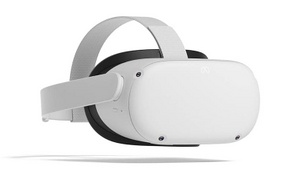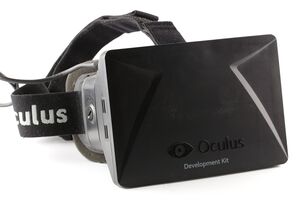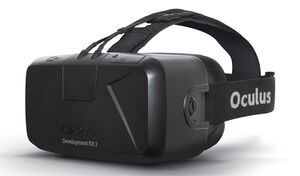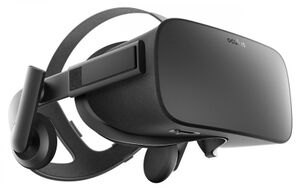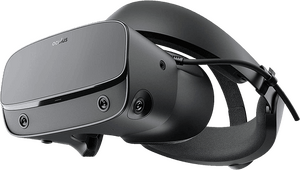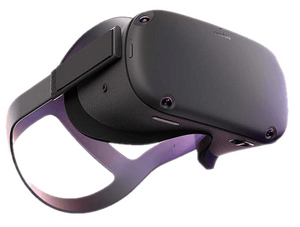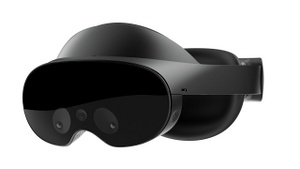Glossary:Meta
See virtual reality headset article for more information. For a list of games, see List of VR games. For the company itself, see Meta.
This is an article containing a list of virtual reality headsets produced by Oculus VR and later Meta.
On PC, Meta's virtual reality headsets support games that utilize Meta's own LibOVR API and the open-sourced OpenXR API. Through Steam, the headsets also play games that use Valve's OpenVR API. Do note that some earlier VR games use earlier version of the LibOVR API and may only support the Rift DK1 and/or DK2, and not support the consumer VR headsets, and in that case, a third-party application LibOVRWrapper is needed for playing those titles with the consumer headsets. For standalone VR headsets, playing games from outside the Oculus Store requires enabling Unknown Sources. PC VR is usually done through Meta's Oculus App or third-party software like ALVA and Virtual Desktop on supported headsets.
General information
Headsets
PC VR
- PC VR headsets cannot be used on its their own and required to be connected to the PC.
- The Rift Core 2.0 update introduces new Dash UI and new minimum and recommended system requirements for the PC VR headsets[1]
Oculus Rift Development Kit 1
The Oculus Rift Development Kit 1, also known as DK1, was Oculus' first release of a headset[2]. It was released on March 29, 2013.
Since it use a 3DoF head tracker, it only supports rotational tracking and no positional tracking, thus it can only be used for seated and a few standing rotational experiences. The DK1 also includes interchangeable lenses for simple dioptric correction.
It is no longer supported by the Oculus Store. Sample article
 |
|
| XInput support | |
|---|---|
| Connection method | |
| USB | |
| Predecessor | |
| Preceding controller | |
| Successor | |
| Succeeding controller | |
Introduction paragraph. Controllername is a game controller/arcade controller/racing wheel developed by company and released/manufactured by company on date. The controller is a pro-orientated or platform-compatible version of other controller, or was released alongside the accompanied video game console.
The controller have multiple features, including on-the-fly remapping, pressure-fit joystick cap, and other notable features. Also note if it has features that were not present on its predecessor. if the controller has more than one models, list the features of Model A here.
The controller is available in three models: The Model A, Model B and Model C. Model B, released on date, has more features that are not present on Model A. Model C, released on date, lacks some features that were present on Model A. Also note the color model(s) available if there's more than one.
The Controllername is a native XInput device, meaning it can supported by games that only use the XInput API. Software can expose the controller's additional features, such as motion control and motorized triggers. The controller need additional first or third-party accessory to work, and what limitation on the controller support.
General infomation
Inputs
- 2 × clickable analog sticks: LS, RS
- 2 × analog triggers: LT, RT
- 2 × digital shoulder buttons: LB, RB
- 4 × digital directional buttons (d-pad): ↑, ↓, ←, →
- 4 × digital face buttons: 𝐀, 𝐁, 𝐗, 𝗬
- 5 × digital functional buttons: -, +, ⌂ ʜᴏᴍᴇ, ꜱᴛᴀʀ, ᴘʀᴏꜰɪʟᴇ
- 2 × digital remappable back buttons: P1, P2
- 1 × mode slider switch: ᴅ - x
Model B inputs
- Motion sensing: Accelerometer, Gyroscope
- 2 × clickable analog sticks: LS, RS
- 2 × analog triggers (acts as digital trigger when connected via Bluetooth): ZL, ZR
- 2 × digital shoulder buttons: 𝐋, 𝐑
- 4 × digital directional buttons (d-pad): ↑, ↓, ←, →
- 4 × digital face buttons: 𝐀, 𝐁, 𝐗, 𝗬
- 5 × digital functional buttons: -, +, ⌂ ʜᴏᴍᴇ, ꜱᴛᴀʀ, ᴘʀᴏꜰɪʟᴇ
- 2 × digital remappable back buttons: P1, P2
- 1 × mode slider switch: ʙʟᴜᴇᴛᴏᴏᴛʜ - 2.4ɢ
- 1 × digital functional button: ᴘᴀɪʀɪɴɢ
Model C inputs
- 2 × clickable analog sticks: LS, RS
- 2 × analog triggers: LT, RT
- 2 × digital shoulder buttons: LB, RB
- 4 × digital directional buttons (d-pad): ↑, ↓, ←, →
- 4 × digital face buttons: 𝐀, 𝐁, 𝐗, 𝗬
- 4 × digital functional buttons: -, +, ⌂ ʜᴏᴍᴇ, ꜱᴛᴀʀ
Controller variations
- List one model per paragraph. Remove if the controller only has one model.
Use with PC platforms
- Add any limitation of the controller usage on PC.
Connection
- Instructions on how to connect the controllers to PC.
- Add info about one connectivity method being only available on one or more specific model.
| Connect instruction |
|---|
|
How to connect the controller to PC. |
Operating System
- Add info about whatever the controller need additional driver install or not on one or more operating system(s).
- List any first and third-party software that support the controller.
Steam
- Add info about controller support on Steam.
Steam Link compatibility
- Add info about controller support via Steam Link on remote device like smartphones.
Controller profile and remapping
- Add info about the instruction on how to change built-in controller profiles and/or remapping buttons.
- Add info about if it requires additional software or not.
- Remove if the controller doesn't support profile switching or remapping, or both.
Hardware
Expansions
- List any first and/or third-party accessories that are compatible with the controller.
Adapters
- List any first and/or third-party adapters that needed for either connect the controller to PC, or connect the associated accessories to the controller or PC.
DIY mods
- List any third-party modification parts that requires the controller to be open up.
Replacement
- List any first-party, user-replaceable parts if the controller has any.
Support in games
- Add and list any info about game support for the controller, and whatever the game support the controller's additional features.
Accessory
- List the box content of the controller if any.
Other information
Technical information
- Device name: Controller, HWID: 0000:0000.
- Change to "model or mode, device name: Controller, HWID: 0000:0000" if the controller have more than one model.
Firmware updates
- Add info about whatever the controller's firmware is updatable or not.
References
- ↑ Rift Core 2.0 Updates: Beta Coming Soon, Plus Redesigned Desktop App Experience - last accessed on May 2023
- ↑ Oculus Rift DK1 Specs - VRcompare - last accessed on 2020-06-22
Oculus Rift Development Kit 2
The Oculus Rift Development Kit 2, also known as DK2, is the second release of the headset for developers. It was released in July 2014.
Unlike the DK1, the DK2 has a single Samsung-sourced OLED screen with higher-resolution (1920 x 1080 with 960 × 1080 per-eye) and running at 75 Hz refresh rate. It now support seated and standing positional tracking through constellation tracking with the use of external IR cameras.
It is still support by the Oculus Store and can be used with an Xbox One Controller to play non- touch controller games.
| Features and specification: | |
|---|---|
| Display type | Single 75Hz Low Persistence OLED |
| Resolution | 960 × 1080 per-eye, 1920 x 1080 of total resolution |
| Lenses | Aspherical lenses |
| IPD range | Fixed 63.5mm |
| Field-of-view | 100° |
| Tracking | Positional tracking with Oculus DK2 IR Camera via constellation tracking. |
| Connection(s) | A HDMI plus a USB-Micro through a split cable. |
Oculus Rift
The consumer version of the Oculus Rift, also known as CV1, is the first consumer-orientated VR headset released on March 28, 2016.
Compare to the DK2, the CV1 now features the dual OLED panels with 1080 x 1200 resolution per-eye and 90Hz refresh rate. The CV1 also have integrated headphone for audio, and have an ability to adjust the IPD.
The CV1 came bundled with two Oculus Sensors for Constellation tracking. Earlier production batches of the headset came with a Xbox Wireless Controller, but later production batches came with a pair of Oculus Touch controller.
The CV1 was discontinued in 2019.
General information
| Features and specification: | |
|---|---|
| 3D | Stereoscopic 3D |
| Display type | Dual 90 Hz Low Persistence OLED |
| Resolution | 1080 x 1200 per-eye, 2160 x 1200 of total resolution |
| Lenses | Aspherical lenses |
| IPD range | 58-72 mm |
| Field-of-view | 110° |
| Tracking | External Oculus Sensor cameras to track the headset and Touch controllers positional via Constellation tracking. Supporting the following configuarations: - 1 x Oculus sensor for seated play with an Xbox One Controller or Oculus Remote. - 2 x Oculus Sensors for standing with Oculus Touch controllers. - 3 x Oculus Sensors for room-scale tracking with Oculus Touch Controllers. |
| Audio | Integrated headphones and microphone. Headphones can be replaced with earphones. |
| Supported controller(s) | Oculus Touch Xbox One Controller |
| Connection(s) | A HDMI 1.3 plus a USB-A 3.0 through a wired control box for the headset, 1 to 3 USB-A 3.0 for the Oculus Sensors. |
| Other feature(s) | Proximity sensor |
Oculus Rift S
The Oculus Rift S is a successor to the CV1, released on March 20, 2019.
Unlike the CV1 which have constellation tracking, the Rift S have inside-out tracking through the use of the headset's five built-in cameras. Unlike the CV1 which has dual OLED panels, the Rift S has a single, fast-switching LCD panel with a 1280 x 1440 resolution per-eye. It was also Oculus's first headset to use the fresnel lenses.
It came bundled with a pair of second-generation Oculus Touch controllers.
It was discontinued in 2021.
General information
| Features and specification: | |
|---|---|
| 3D | Stereoscopic 3D |
| Display type | Single 80 Hz Fast-switch LCD |
| Resolution | 1280 x 1440 per-eye, 2560 x 1440 of total resolution |
| Lenses | Fresnel lenses |
| IPD range | 58-72 mm |
| Field-of-view | 115° |
| Tracking | Five built-in cameras for inside-out tracking. Oculus Sensors for the original Rift can be optionally used to enhance tracking quality. |
| Audio | Speakers are integrated into the headband. 3.5mm headphone jack is present to use external headphones. |
| Supported controller(s) | Oculus Touch (2nd-generation) |
| Connection(s) | A DisplayPort 1.2 plus a USB-A 3.0 through a detachable split cable for the headset. |
Standalone VR
Oculus Quest
The Oculus Quest is the first standalone VR headset that was released on May 21, 2019.
Just like the Rift S, the Quest have inside-out tracking with its four built-in cameras. It has a dual OLED panels with a 1440 x 1600 resolution per-eye. As a standalone VR headset, the Quest is powered by a Qualcomm Snapdragon 835 SoC, with 4 GB of system memory and 64 GB or 128 GB of storage. Originally, it was released with the custom OS based on Android 7.1.1, but had been since updated to Android 10.
Pairing with PC for PC VR is possible with a single Oculus Link cable in wired configuration, or Wi-Fi via Air Link in wireless configuration. The headset came bundled with a pair of second-generation Oculus Touch controllers.
It was discontinued in 2020.
General information
| Features and specification: | |
|---|---|
| 3D | Stereoscopic 3D |
| Display type | Dual 72 Hz OLED |
| Resolution | 1440 x 1600 per-eye, 2880 x 1600 of total resolution |
| Lenses | Fresnel lenses |
| IPD range | 58-72 mm |
| Field-of-view | 110° |
| Tracking | Four built-in cameras for inside-out tracking. |
| Audio | Built-in headphones. Two 3.5mm headphone jacks are present to use external headphones. |
| Supported controller(s) | Oculus Touch (2nd-generation) |
| Connection(s) | USB-C for wired connection and Wi-Fi 5 for wireless connection. |
| Operating system (OS) | Quest system software based on Android 7.1.1 at launch. Updated to Android 10 via update. |
| System-on-chip (SoC) | Qualcomm Snapdragon 835 |
| Memory | 4 GB LPDDR4X |
| Storage | 64 GB, 128 GB |
| Battery capacity | 3648 mAh |
Meta Quest 2
The Meta Quest 2, formerly Oculus Quest 2, is the second standalone VR headset released on October 13, 2020.
Compare the original Quest, the Quest 2 have numerous hardware changes; Powering the headset is a Qualcomm Snapdragon XR2 SoC, with 6 GB of system memory and 64 GB / 128 GB / 256 GB of storage. It has a single LCD panel with a 1832 x 1920 resolution per-eye and run at 90 Hz, but can be run at 120 Hz with software updates. Originally, it was released with the custom OS based on Android 10, but had been since updated to Android 12.1.
Pairing with PC for PC VR is possible with a single Oculus Link cable in wired configuration, or with Wi-Fi in wireless configuration. The headset came bundled with a pair of third-generation Oculus Touch controllers.
General information
Sample article
 |
|
| XInput support | |
|---|---|
| Connection method | |
| USB | |
| Predecessor | |
| Preceding controller | |
| Successor | |
| Succeeding controller | |
Introduction paragraph. Controllername is a game controller/arcade controller/racing wheel developed by company and released/manufactured by company on date. The controller is a pro-orientated or platform-compatible version of other controller, or was released alongside the accompanied video game console.
The controller have multiple features, including on-the-fly remapping, pressure-fit joystick cap, and other notable features. Also note if it has features that were not present on its predecessor. if the controller has more than one models, list the features of Model A here.
The controller is available in three models: The Model A, Model B and Model C. Model B, released on date, has more features that are not present on Model A. Model C, released on date, lacks some features that were present on Model A. Also note the color model(s) available if there's more than one.
The Controllername is a native XInput device, meaning it can supported by games that only use the XInput API. Software can expose the controller's additional features, such as motion control and motorized triggers. The controller need additional first or third-party accessory to work, and what limitation on the controller support.
General infomation
Inputs
- 2 × clickable analog sticks: LS, RS
- 2 × analog triggers: LT, RT
- 2 × digital shoulder buttons: LB, RB
- 4 × digital directional buttons (d-pad): ↑, ↓, ←, →
- 4 × digital face buttons: 𝐀, 𝐁, 𝐗, 𝗬
- 5 × digital functional buttons: -, +, ⌂ ʜᴏᴍᴇ, ꜱᴛᴀʀ, ᴘʀᴏꜰɪʟᴇ
- 2 × digital remappable back buttons: P1, P2
- 1 × mode slider switch: ᴅ - x
Model B inputs
- Motion sensing: Accelerometer, Gyroscope
- 2 × clickable analog sticks: LS, RS
- 2 × analog triggers (acts as digital trigger when connected via Bluetooth): ZL, ZR
- 2 × digital shoulder buttons: 𝐋, 𝐑
- 4 × digital directional buttons (d-pad): ↑, ↓, ←, →
- 4 × digital face buttons: 𝐀, 𝐁, 𝐗, 𝗬
- 5 × digital functional buttons: -, +, ⌂ ʜᴏᴍᴇ, ꜱᴛᴀʀ, ᴘʀᴏꜰɪʟᴇ
- 2 × digital remappable back buttons: P1, P2
- 1 × mode slider switch: ʙʟᴜᴇᴛᴏᴏᴛʜ - 2.4ɢ
- 1 × digital functional button: ᴘᴀɪʀɪɴɢ
Model C inputs
- 2 × clickable analog sticks: LS, RS
- 2 × analog triggers: LT, RT
- 2 × digital shoulder buttons: LB, RB
- 4 × digital directional buttons (d-pad): ↑, ↓, ←, →
- 4 × digital face buttons: 𝐀, 𝐁, 𝐗, 𝗬
- 4 × digital functional buttons: -, +, ⌂ ʜᴏᴍᴇ, ꜱᴛᴀʀ
Controller variations
- List one model per paragraph. Remove if the controller only has one model.
Use with PC platforms
- Add any limitation of the controller usage on PC.
Connection
- Instructions on how to connect the controllers to PC.
- Add info about one connectivity method being only available on one or more specific model.
| Connect instruction |
|---|
|
How to connect the controller to PC. |
Operating System
- Add info about whatever the controller need additional driver install or not on one or more operating system(s).
- List any first and third-party software that support the controller.
Steam
- Add info about controller support on Steam.
Steam Link compatibility
- Add info about controller support via Steam Link on remote device like smartphones.
Controller profile and remapping
- Add info about the instruction on how to change built-in controller profiles and/or remapping buttons.
- Add info about if it requires additional software or not.
- Remove if the controller doesn't support profile switching or remapping, or both.
Hardware
Expansions
- List any first and/or third-party accessories that are compatible with the controller.
Adapters
- List any first and/or third-party adapters that needed for either connect the controller to PC, or connect the associated accessories to the controller or PC.
DIY mods
- List any third-party modification parts that requires the controller to be open up.
Replacement
- List any first-party, user-replaceable parts if the controller has any.
Support in games
- Add and list any info about game support for the controller, and whatever the game support the controller's additional features.
Accessory
- List the box content of the controller if any.
Other information
Technical information
- Device name: Controller, HWID: 0000:0000.
- Change to "model or mode, device name: Controller, HWID: 0000:0000" if the controller have more than one model.
Firmware updates
- Add info about whatever the controller's firmware is updatable or not.
References
Meta Quest Pro
The Meta Quest Pro is a business-and-enthusiast-grade VR headset released on October 25, 2022.
Compare to the Quest 2, the Quest Pro have differences in hardware; It is powered by a Qualcomm Snapdragon XR2+ SoC, with 12 GB of system memory and 256 GB of storage. Unlike past VR headsets which use either aspheric lenses or fresnel lenses, the Quest Pro use the pancake lenses. It has a dual LCD panels with a 1800 x 1920 resolution and run at 90 Hz refresh rate. The Quest Pro also have a single RGB camera for camera passthrough, and has eye tracking and face tracking for supported applications.
Just like the Quest 2, pairing with PC for PC VR is possible with a single Oculus Link cable in wired configuration, or with Wi-Fi in wireless configuration. It came bundled with a pair of Touch Pro controllers.
General information
| Features and specification: | |
|---|---|
| 3D | Stereoscopic 3D |
| Display | Dual 90 Hz LCD with local dimming |
| Resolution | 1800 x 1920 per-eye, 3600 x 1920 of total resolution |
| Lenses | Pancake lenses |
| IPD range | 55-75 mm |
| Field-of-view | 106° |
| Tracking | Two built-in cameras for inside-out tracking. |
| Audio | Built-in headphones. A single 3.5mm headphone jack is present to use external headphone. |
| Supported controller(s) | Meta Quest Touch Pro |
| Connection(s) | USB-C for wired connection and Wi-Fi 6E for wireless connection. |
| Operating system (OS) | Quest system software based on Android. |
| System-on-chip (SoC) | Qualcomm Snapdragon XR2+ |
| Memory | 12 GB LPDDR5 |
| Storage | 256 GB |
| Battery capacity | 5348 mAh |
| Other feature(s) | Built-in eye tracking and face tracking. |
Meta Quest 3
The Meta Quest 3 is an upcoming consumer standalone VR headset, set to be released in late 2023.
Just like the Quest Pro, it use the pancake lenses. It is powered by a unspecified Qualcomm Snapdragon SoC.
The headset will came bundled with a pair of Meta Quest Touch Plus controllers.
General information
| Features and specification: | |
|---|---|
| 3D | Stereoscopic 3D |
| Display | TBA |
| Resolution | TBA |
| Lenses | Pancake lenses |
| IPD range | TBA |
| Field-of-view | TBA |
| Tracking | Four built-in cameras for inside-out tracking. |
| Audio | Built-in headphones. A single 3.5mm headphone jack is present to use external headphone. |
| Supported controller(s) | Meta Quest Touch Plus Meta Quest Touch Pro (optional) |
| Connection(s) | USB-C for wired connection and Wi-Fi 6E for wireless connection. |
| Operating system (OS) | Quest system software based on Android. |
| System-on-chip (SoC) | Unspecified Qualcomm Snapdragon |
| Memory | TBA |
| Storage | 128 GB |
| Battery capacity | TBA |
Controllers
Oculus Remote
Comes in the box, can be used to play simple movies and experiences that don't require interaction or gameplay.
Touch controllers
As of June 2023, there are fourth iterations of the standard Touch controllers.
Oculus Touch
The first-generation Touch controllers were made specifically for the CV1. The standalone set came with an additional Oculus Sensor.
Oculus Touch (2nd-generation)
The second-generation Touch controllers were only available as bundles with the Oculus Rift S and the Oculus Quest.
Oculus Touch (3rd-generation)
The third-generation Touch controllers were available either as a bundle with the Meta Quest 2 or as a standalone set.
Meta Quest Touch Plus
The upcoming Meta Quest Touch Plus are the fourth-generation Touch controllers, available as a bundle with the upcoming Meta Quest 3.
Meta Quest Touch Pro
The Touch Pro controllers are available either bundled with the Quest Pro VR headsets or as a standalone set. In case of the standalone set, they came with a charging dock.
System Requirement
- System Requirements for PC VR only headsets and standalone headsets varies.
Rift and Rift S
| Windows | ||
|---|---|---|
| Minimum | Recommended | |
| Operating system (OS) | 10 | |
| Processor (CPU) | Intel Core i3-6100 AMD FX-4350 AMD Ryzen 3 1200 |
Intel Core i5-4590 AMD Ryzen 5 1500X |
| System memory (RAM) | 8 GB | 8 GB+ |
| Hard disk drive (HDD) | ||
| Video card (GPU) | Nvidia GeForce GTX 1050 Ti Nvidia GeForce GTX 960 AMD Radeon RX 470 AMD Radeon R9 290 | Nvidia GeForce GTX 1060 Nvidia GeForce GTX 970 AMD Radeon RX 480 AMD Radeon R9 290 |
| Other | Rift 1x USB 3.0, 2x USB 2.0 HDMI 1.3 Rift S 1x USB 3.0 DisplayPort 1.2 or Mini DisplayPort |
Rift 3x USB 3.0, 1x USB 2.0 HDMI 1.3 Rift S 1x USB 3.0 DisplayPort 1.2 |
Quest, Quest 2 and Quest Pro
| Windows | ||
|---|---|---|
| Minimum | Recommended | |
| Operating system (OS) | 10, 11 | |
| Processor (CPU) | Intel i5-4590 AMD Ryzen 5 1500X | |
| System memory (RAM) | 8 GB+ | |
| Hard disk drive (HDD) | ||
| Video card (GPU) | NVIDIA GeForce GTX 970 NVIDIA GeForce GTX 1060 3 GB/6 GB AMD Radeon RX 400 Series | |
| Other | USB-C Wi-Fi 5 |
USB-C Wi-Fi 6/6E |

